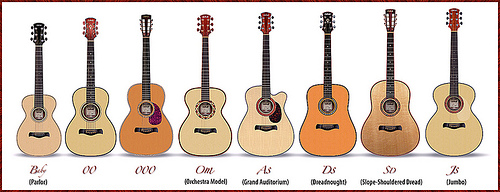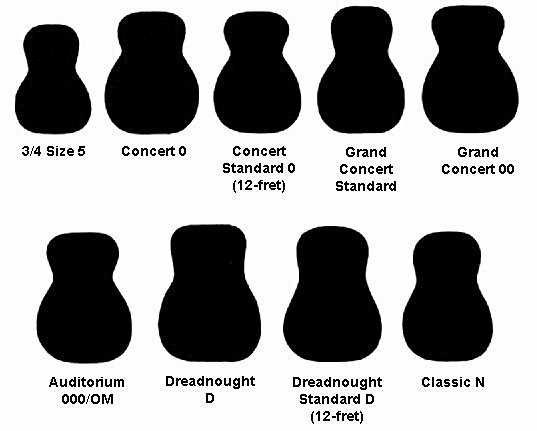Types of Acoustic Guitars
The more culturally diverse or globally accepted an instrument is, the more variations you will find for it. The same goes for a guitar. With the similarity of the structure ending with the hollow box and the fretboard, here are the types of acoustic guitars found world-wide.
.jpg)
Acoustic guitars are wonderful instruments that have played a very significant part in the music revolution. Technology created the electric guitar for us, making the world of guitars all the more appealing to the masses. Still, a majority of musicians prefer acoustic guitars over their electric counterparts, due to a natural tone and the versatility in playing style. You'll still find a horde of genres all over that prefer the acoustic, like country, soft rock or western classical. Understanding the varieties of acoustic guitars is real fun. You have many types of acoustic guitars sorted out according to the body shape, kinds and number of strings used, etc.

-
♪ Two Primary Types of Acoustic Guitars ♪
The prominent features of classical guitars are nylon strings and a broad fretboard. These guitars are mostly used by jazz musicians and guitarists who are into classical music. Some people even refer to them as Spanish guitars and nylon-stringed guitars. Just because nylon strings are quite easy on the fingertips, these guitars are greatly preferred by novice guitarists.
Folk guitars are standard acoustics which are commonly found in the guitar playing community. They have bronze strings, which makes them sound very different from the nylon-stringed acoustic guitars. Folk guitars are further divided into a wide range of acoustic guitars, depending on the number of strings and the body style.
Note that the above mentioned are two broad types, which do include the acoustic guitars mentioned in the following. Let us now get to know the kinds of acoustic guitars owing to specifics.

2. ♪ Commonly Seen Acoustic Guitars ♪
These are the ones that you get to see everywhere around you. They have a wide use in multiple styles of music, whether it's classical or even rock. The following types of guitars are what you'll mostly find still in production with the world's best brands.
-
12-String Acoustic Guitars
Twice the number of strings, twice the sound. You get one string right under every regular string that you can find in a 6-stringed guitar. The additional string is tuned to the same note as the original, only an octave higher. This gives a 12-stringed guitar an unbelievable full tone and splendid resonance. A slight drawback with these guitars includes high maintenance and scarcity of finding a spare set of strings (you need to buy the entire 12 set of strings). Another problem is that the fullness of sound is not necessarily a good thing for all songs. Songs like "Wish you were here" were created on a 12-stringed and therefore sound best on the same, but a majority of songs composed on a 6-stringed guitar won't sound the same when played on a 12-string.
History has it that a resonator guitar was created to help get a louder sound off a guitar, as it would always get sidetracked by percussion and rhythm instruments in an orchestra. As time passed, we found the use for amplifiers in music. At this point the resonator guitar simply shifted its dominance from mainstream music to country and bluegrass music. A resonator guitar is nothing but a classical guitar that uses a steel soundboard than a wooden one and steel strings, for added sound.
Jumbo guitars come in the category of standard folk guitars. These types have a big body which produces a good amount of acoustic sound. They were the rage before the electric guitar era. They were used almost everywhere, but had more standing in jazz, back when it was big. A well-made jumbo can get you the depth of a dreadnought, while keeping the smoothness of a classical concert acoustic. A jumbo guitar has round shoulders and bottom, with the body behind the bridge much wider than other guitars. This is what gives it a deep sound.
The dreadnought guitars are the most common guitars you'll find. They can cover all aspects of sound with decent precision. They can be used for typical slow-strumming songs for beginners to advanced finger-plucking. They produce the loudest sound of all acoustic guitars when it comes to strumming. The dreadnought was made popular during the rock era, right after the '60s. You can identify a dreadnought by its square shoulders and bottom. Most dreadnoughts don't have an open fretboard after the 14th fret.
They're acoustic guitars that have bass strings on them. Or rather, they're bass guitars with hollow wooden soundboards. The modern acoustic bass guitar is a derivation of the traditional Mexican bass guitars (which includes the ridiculously large Guitarrón). They are used for creating a clear and natural bass sound. It is quite impossible to hear an unplugged acoustic bass guitar in between a musical arrangement, making it mandatory to have a pickup attached to the guitar. The acoustic bass guitars are generally used in jazz and soft rock music.
An electro-acoustic guitar is typically a normal acoustic guitar, but permanently attached with pickups for sound amplification. These are used by singers who want to use acoustics in front of a large crowd. They usually have tuners, equalizer controls, and volume knobs on the body. They can be played without being plugged in, but rarely sound as good a conventional acoustic guitar.
As the name suggests, it has an arched top and back. It has the regular 6-strings and is generally meant to be an electric-acoustic guitar that comes with its own Humbucker pickups. They can produce a very powerful sound in capable hands.

3. ♪ Rare Acoustic Guitars ♪
These are hard to come by everyday and are generally restricted to a single style or genre of music.
A type of acoustic guitar kept only to the art of Flamenco. An easy way to recognize them is pick-guards on both sides of the strings on the box. This is because the Flamenco style includes a lot of percussion on the strumming hand itself, so you need to protect the wood on the guitar.
I mention the Baroque since we still have a handful of guitarists playing it. It is basically a predecessor to the Classic acoustic guitar and has a unique and easily identifiable shape.
A harp-guitar is one of the older versions of stringed instruments that resembles an acoustic guitar. Today, the harp guitar comes mostly customized, according to the user's wishes. The main guitar body is similar to a classical acoustic guitar, with an additional wooden extension on top. This extension houses open strings that are meant to be played as they are. This is why they need to be customized, then the user can define the spectrum of notes the open harp strings can play. Although an extremely rare guitar to be seen, we have some of the most phenomenal acoustic guitarists using the harp-guitar, including French-Canadian artist Antoine Dufour and American guitarist Andy McKee.
>> I've summarized the more common types of acoustic guitars. If you dig deeper into the world of stringed instruments, you'll find more and more fascinating instruments that you may find appealing to your taste.
Valote
Collectibles: Stephen Rampur - buzzle